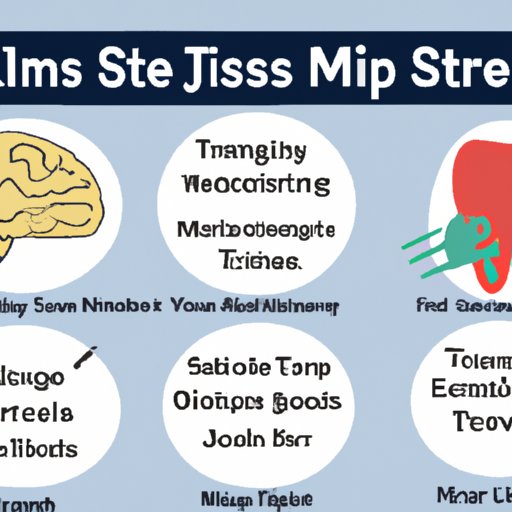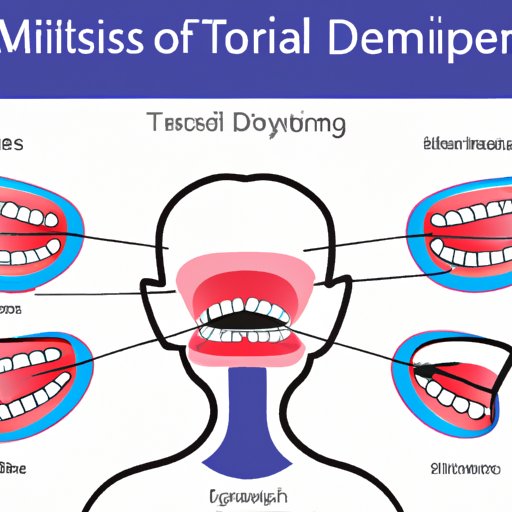Introduction
TMJ disorder is a common condition characterized by pain in the jaw joint and surrounding muscles. Symptoms can range from mild discomfort to severe pain and can make everyday activities like eating, talking, and even sleeping unbearable. The causes of TMJ disorder are varied, and its symptoms can be challenging to manage. This article will explore the different causes of TMJ disorder, its symptoms, and a range of treatment options. Readers will learn about home remedies, exercises, surgical options, physical therapy, and tips for managing stress and anxiety to relieve or prevent TMJ symptoms.
Overview of the Causes and Symptoms of TMJ Disorder and Possible Treatment Options
The exact causes of TMJ disorder are not always clear but may include teeth grinding, jaw clenching, arthritis, injuries, misaligned teeth, or stress. But whatever the cause, TMJ disorder commonly produces symptoms such as jaw pain, stiffness, and difficulty opening or closing the mouth. Headaches, dizziness, and earaches may also accompany the pain. If left untreated, TMJ disorder can lead to chronic joint inflammation or damage. There are several treatment options for TMJ disorder, including medication, oral appliances, and even surgery, but options depend on the severity of the case.
Home Remedies for TMJ Pain Relief
There are several home remedies that people can try to relieve TMJ pain. These methods are natural, easily accessible, and inexpensive to perform. Examples of home remedies for TMJ disorder include moist heat or cold therapy, eating soft foods, avoiding extreme jaw movements, practicing relaxation techniques, and using essential oils. Applying moist heat to the affected area can reduce pain and relax muscles. To do this, apply a warm, damp towel to the jaw for 10-15 minutes a few times a day. Similarly, applying a cold pack can reduce swelling and inflammation. It’s essential to avoid extreme jaw movements, stress, or poor posture to prevent aggravating the symptoms, and practicing relaxation techniques and using essential oils can also be incredibly beneficial.
Exercises and Stretches to Relax TMJ Muscles
Exercises and stretches can help ease TMJ pain by relaxing the jaw muscles and reducing tension. The exercises and stretches typically include gentle jaw, neck, and shoulder movements that help alleviate TMJ disorder symptoms. To perform these exercises, start by sitting straight and relaxed, then slowly and gently move your jaw in different directions to promote relaxation. Yawning, massaging the jaw muscles, and avoiding clenching the teeth or chewing gum can also help. However, consider consulting a medical professional before attempting any exercise or stretching regimens.
Understanding the Options for TMJ Surgery
If your TMJ symptoms are severe and non-responsive to other treatments, surgery may be necessary. There are several surgical options available, including arthroscopy, open-joint surgery, condylotomy, and arthrocentesis. Arthroscopy is a minimally invasive procedure that involves inserting small instruments to repair joint tissue damage. Open-joint surgery, on the other hand, is a more in-depth procedure where the surgeon operates directly on the joint area. Condylotomy involves changes to the mandible’s bone structure, and arthrocentesis can remove excess fluid build-up. However, be aware that surgery comes with risks, and it is essential to discuss all surgical options and their potential risks and benefits with a medical professional before deciding.
Understanding the Benefits of Physical Therapy for TMJ
Physical therapy can be an effective treatment option for TMJ disorder by strengthening the jaw and neck muscles, improving mobility, and reducing symptoms. Physical therapy exercises may include range-of-motion exercises, muscle strengthening, and stretching of the jaw and neck. However, physical therapy should be administered by a licensed physical therapist, and individualized treatment should be discussed with a qualified medical professional.

Tips for Managing Stress and Anxiety to Prevent TMJ Symptoms
Stress and anxiety can worsen TMJ symptoms, so it’s essential to find ways to manage them. Several strategies can help manage stress and, in turn, prevent the onset of TMJ disorder symptoms. These include practicing relaxation techniques like deep breathing, yoga, or meditation, getting enough sleep, staying active and exercising regularly, and maintaining a healthy diet. Additionally, taking the time to do activities that you enjoy, socializing, and spending time with loved ones can also be beneficial in managing stress and anxiety.
Conclusion
TMJ disorder is a challenging condition that can interfere with daily life, but there are several ways of treating and managing the associated symptoms. Home remedies, exercises, surgical options, physical therapy, and stress management strategies can help alleviate TMJ disorder pain, stiffness, and other complications. It’s essential to consult with a qualified medical professional to discuss each treatment option’s risks and benefits, determine the most appropriate for your needs, and avoid self-medicating or self-treating. With proper management and treatment, people who experience TMJ disorder can enjoy improved quality of life and a pain-free life.
